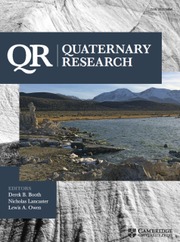Crossref Citations
This article has been cited by the following publications. This list is generated based on data provided by
Crossref.
Mayer, James H
Burr, George S
and
Holliday, Vance T
2008.
Comparisons and Interpretations of Charcoal and Organic Matter Radiocarbon Ages from Buried Soils in North-Central Colorado, USA.
Radiocarbon,
Vol. 50,
Issue. 3,
p.
331.
Placzek, Christa
Quade, Jay
Betancourt, Julio L.
Patchett, P. Jonathan
Rech, Jason A.
Latorre, Claudio
Matmon, Ari
Holmgren, Camille
and
English, Nathan B.
2009.
CLIMATE IN THE DRY CENTRAL ANDES OVER GEOLOGIC, MILLENNIAL, AND INTERANNUAL TIMESCALES1.
Annals of the Missouri Botanical Garden,
Vol. 96,
Issue. 3,
p.
386.
Zech, Jana
Zech, Roland
Kubik, Peter W.
and
Veit, Heinz
2009.
Glacier and climate reconstruction at Tres Lagunas, NW Argentina, based on 10Be surface exposure dating and lake sediment analyses.
Palaeogeography, Palaeoclimatology, Palaeoecology,
Vol. 284,
Issue. 3-4,
p.
180.
Placzek, Christa
Quade, Jay
Rech, Jason A.
Patchett, P.J.
and
Pérez de Arce, Carlos
2009.
Geochemistry, chronology and stratigraphy of Neogene tuffs of the Central Andean region.
Quaternary Geochronology,
Vol. 4,
Issue. 1,
p.
22.
Maldonado, Antonio
Méndez, Cesar
Ugalde, Paula
Jackson, Donald
Seguel, Roxana
and
Latorre, Claudio
2010.
Early Holocene climate change and human occupation along the semiarid coast of north‐central Chile.
Journal of Quaternary Science,
Vol. 25,
Issue. 6,
p.
985.
Placzek, C.J.
Matmon, A.
Granger, D.E.
Quade, J.
and
Niedermann, S.
2010.
Evidence for active landscape evolution in the hyperarid Atacama from multiple terrestrial cosmogenic nuclides.
Earth and Planetary Science Letters,
Vol. 295,
Issue. 1-2,
p.
12.
Rech, Jason A.
Currie, Brian S.
Shullenberger, Eric D.
Dunagan, Stan P.
Jordan, Teresa E.
Blanco, Nicolás
Tomlinson, Andrew J.
Rowe, Harry D.
and
Houston, John
2010.
Evidence for the development of the Andean rain shadow from a Neogene isotopic record in the Atacama Desert, Chile.
Earth and Planetary Science Letters,
Vol. 292,
Issue. 3-4,
p.
371.
Bromley, Gordon R.M.
Hall, Brenda L.
Rademaker, Kurt M.
Todd, Claire E.
and
Racovteanu, Adina E.
2011.
Late Pleistocene snowline fluctuations at Nevado Coropuna (15°S), southern Peruvian Andes.
Journal of Quaternary Science,
Vol. 26,
Issue. 3,
p.
305.
Cartwright, Alyson
Quade, Jay
Stine, Scott
Adams, Kenneth D.
Broecker, Wallace
and
Cheng, Hai
2011.
Chronostratigraphy and lake-level changes of Laguna Cari-Laufquén, Río Negro, Argentina.
Quaternary Research,
Vol. 76,
Issue. 3,
p.
430.
Riquelme, Rodrigo
Rojas, Constanza
Aguilar, Germán
and
Flores, Pablo
2011.
Late Pleistocene–early Holocene paraglacial and fluvial sediment history in the Turbio valley, semiarid Chilean Andes.
Quaternary Research,
Vol. 75,
Issue. 1,
p.
166.
Aguilar, Germán
Riquelme, Rodrigo
Martinod, Joseph
Darrozes, José
and
Maire, Eric
2011.
Variability in erosion rates related to the state of landscape transience in the semi‐arid Chilean Andes.
Earth Surface Processes and Landforms,
Vol. 36,
Issue. 13,
p.
1736.
Placzek, Christa J.
Quade, Jay
and
Patchett, P. Jonathan
2011.
Isotopic tracers of paleohydrologic change in large lakes of the Bolivian Altiplano.
Quaternary Research,
Vol. 75,
Issue. 1,
p.
231.
Londoño, Ana Cristina
Forman, Steven L.
Eichler, Timothy
and
Pierson, James
2012.
Episodic eolian deposition in the past ca. 50,000years in the Alto Ilo dune field, southern Peru.
Palaeogeography, Palaeoclimatology, Palaeoecology,
Vol. 346-347,
Issue. ,
p.
12.
McGLUE, MICHAEL M.
ELLIS, GEOFFREY S.
COHEN, ANDREW S.
and
SWARZENSKI, PETER W.
2012.
Playa‐lake sedimentation and organic matter accumulation in an Andean piggyback basin: the recent record from the Cuenca de Pozuelos, North‐west Argentina.
Sedimentology,
Vol. 59,
Issue. 4,
p.
1237.
Marquet, Pablo A.
Santoro, Calogero M.
Latorre, Claudio
Standen, Vivien G.
Abades, Sebastián R.
Rivadeneira, Marcelo M.
Arriaza, Bernardo
and
Hochberg, Michael E.
2012.
Emergence of social complexity among coastal hunter-gatherers in the Atacama Desert of northern Chile.
Proceedings of the National Academy of Sciences,
Vol. 109,
Issue. 37,
p.
14754.
Pigati, Jeffrey S.
Latorre, Claudio
Rech, Jason A.
Betancourt, Julio L.
Martínez, Katherine E.
and
Budahn, James R.
2012.
Accumulation of impact markers in desert wetlands and implications for the Younger Dryas impact hypothesis.
Proceedings of the National Academy of Sciences,
Vol. 109,
Issue. 19,
p.
7208.
Ruch, J.
Warren, J.K.
Risacher, F.
Walter, T.R.
and
Lanari, R.
2012.
Salt lake deformation detected from space.
Earth and Planetary Science Letters,
Vol. 331-332,
Issue. ,
p.
120.
Gayo, E. M.
Latorre, C.
Santoro, C. M.
Maldonado, A.
and
De Pol-Holz, R.
2012.
Hydroclimate variability in the low-elevation Atacama Desert over the last 2500 yr.
Climate of the Past,
Vol. 8,
Issue. 1,
p.
287.
Díaz, Francisca P.
Latorre, Claudio
Maldonado, Antonio
Quade, Jay
and
Betancourt, Julio L.
2012.
Rodent middens reveal episodic, long‐distance plant colonizations across the hyperarid Atacama Desert over the last 34,000 years.
Journal of Biogeography,
Vol. 39,
Issue. 3,
p.
510.
Gayo, Eugenia M.
Latorre, Claudio
Jordan, Teresa E.
Nester, Peter L.
Estay, Sergio A.
Ojeda, Karla F.
and
Santoro, Calogero M.
2012.
Late Quaternary hydrological and ecological changes in the hyperarid core of the northern Atacama Desert (~21°S).
Earth-Science Reviews,
Vol. 113,
Issue. 3-4,
p.
120.

